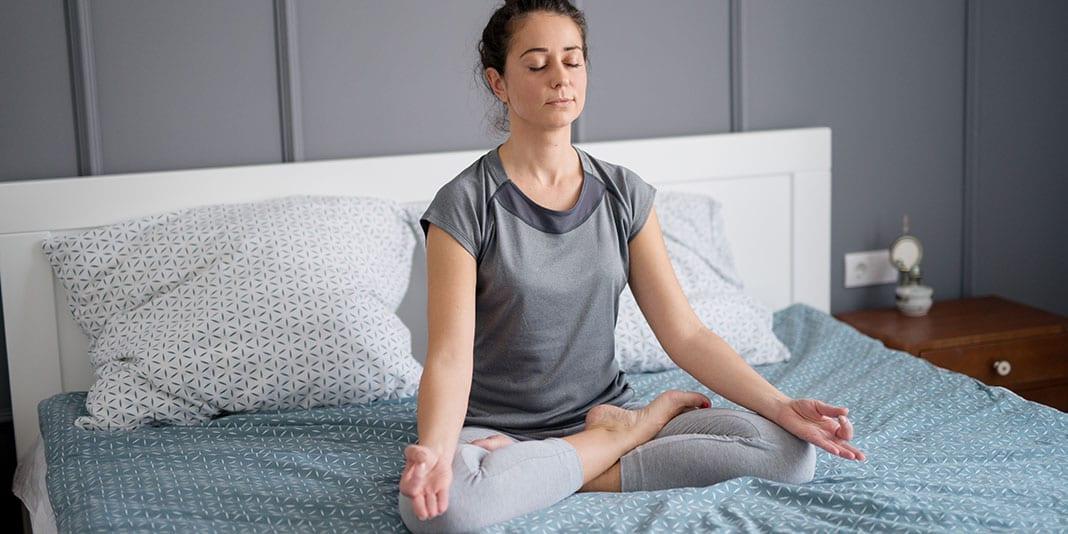Our back is really an amazing feat of engineering. For one thing, our spine is a structure made up of 33 bones called vertebrae that support our entire body.
Nearly every motion we make has a corresponding effect in our spine. Not only that, but our spinal bones are connected to an incredibly complex pathway of nerves, as well muscles, ligaments, discs and joints.
It’s not surprising, then, that figuring out where pain is coming from in this highly intricate piece of anatomy often amounts to a good deal of guesswork. Even with X-rays and MRIs (magnetic resonance imaging, which uses radio waves and magnets to create cross-sectional images), “85 percent of the time, it’s difficult to pinpoint a precise cause for back pain,” says Daniel Mazanec, MD, the associate director of the Center for Spine Health at the Cleveland Clinic and a medical acupuncturist.
Try this
Stimulate Your Core: Lie flat on your back with your knees bent. Place your thumbs on the bottom of your floating rib and your index fingers on the tops of your hipbones. Inhale and feel the space expand; exhale and forcefully push all the air out of your lungs, concentrating on using your abdominal muscles to push your belly button back to your spine. As you do this, you’ll feel the space between your thumbs and forefingers contract. Keep the tension (belly button to spine) for a count of 10 seconds. Inhale, exhale and repeat five to 10 times, twice a day.
Some of the biggest causes of back pain, such as soft tissue injuries (muscular injuries or ligament sprains/strains), can’t be seen in an MRI or X-ray. And the things that can be imaged, such as joints, discs, bones and nerves, don’t always tell the whole story.
For instance, even if the MRI shows an abnormality, it may not be what’s causing the pain. Less common causes of back pain are due to spinal nerve issues, primarily related to disc problems, bony spurs from arthritis or a combination of both; these affect around 5 to 10 percent of people.
While the cause of your back pain may remain a mystery, a qualified physician or physical therapist, for instance, can still devise a successful treatment and prevention plan. Taking into account your symptoms, current health, diet, activity level and medical history, your doctor will tailor a plan just for you.
The even better news: No matter what’s causing your spine to ache, 99 percent of people do not need surgery to eliminate their back pain, says Dr. Mazanec.
QUIZ: How Healthy Do You Feel?
Common Causes of Back Pain
Lifestyle plays a huge role in back injuries. Major factors include:
- Weight. Being overweight is a big trigger. Your discs — the jelly-like tissues that cushion the bones of your spine — take a real beating, thanks to the excess weight creating constant pressure on them. In general, people with a body mass index of 30 or greater are at the most risk of developing back pain due to extra weight. Pregnancy weight gain, which is unevenly distributed, can also do a real number on your back. (If you’re pregnant, do your baby and your back a favor and stay within the recommended weight gain guidelines.) For overweight folks, incorporating regular exercise (see below) and healthy eating habits can reduce the number on the scale and, consequently, your back pain.
- Inactivity. If you don’t move your body, you’re going to gain weight and weaken your lower back and abdominal muscles, known as your core. A weak core can put incredible strain on your back. By strengthening it, you put less pressure on your spine.
- Occupational hazards. We’re not talking about high-rise window washers! Sitting at a desk for eight hours a day (especially with poor posture) is one of the worst things for your back because it puts extra pressure on your discs, says Dr. Mazanec.
- Overuse. Active people have plenty of back issues too. If you’re a runner, for instance, the front of your legs might become stronger than the back, or your legs may be strong, but your core could be relatively weak. Over time, these muscle imbalances affect the way your pelvis rocks back and forth when you run. Eventually, it can lead to misalignment and pain. The bottom line: All sports and workouts come with overuse risks. No matter what you do, core-strengthening exercises (such as Pilates) can help you balance your flexibility and muscle strength and, consequently, protect your back.
- Smoking. “It’s not a well-known risk factor, but it’s a big one,” Dr. Mazanec says. Your jelly-like discs are largely made of fluid and naturally start to lose fluid as you age. The nicotine in cigarettes speeds up this process because it causes blood vessels to constrict, which ultimately starves your discs of nutrients.
- Age. We’re talking about the simple wear and tear on your discs and joints that occurs over time. Frail bones from age-related conditions like osteoporosis are also a factor.
- Stress. A lot of people hold tension in their neck and upper back, which can cause back pain. “Clearly, there is a mind-body connection with some back pain,” Dr. Mazanec says. When he and his colleagues suspect that stress is playing a major role in the pain, they recommend treatments such as acupuncture and biofeedback to help a patient learn to relax those tense muscles.
Bye-Bye, Back Pain
Treatment for back pain varies widely. For acute flare-ups (back pain that seems to come out of nowhere that’s not the result of a trauma like a car accident), your best plan of action is:
- Rest for the first 24 to 48 hours while placing an ice pack on the affected area to help reduce inflammation. Apply for 10 to 20 minutes (depending on what’s comfortable), then take the ice pack off for 10 to 20 minutes, and repeat.
- Try over-the-counter (OTC) pain relievers. Acetaminophen works as well for back pain as nonsteroidal anti-inflammatories (NSAIDs), including naproxen and ibuprofen, says Dr. Mazanec. Because the risks of NSAIDs (stomach upset and bleeding) increase with age, acetaminophen is a safer choice for older adults and those with a history of stomach ulcers. Acetaminophen is also the only OTC pain reliever approved for pregnant women. Before taking a pain reliever, always check with your doctor first to see about possible interactions with medicines you may already be taking. Dr. Mazanec also recommends capsaicin cream (made from hot peppers and available without a prescription) to relieve back pain. It should be applied to the painful area three to four times daily. He advises washing your hands carefully afterward because it can burn if accidentally brushed into the eyes.
- Get moving as soon as you can. “The worst advice is to go to bed for a week. Prolonged bed rest deconditions and weakens you more,” says Dr. Mazanec. After the first day or two of rest, start with gentle movement and stretching, then work up to your usual exercise routine. (And if you don’t have one, start! Your back will thank you.)
Chronic Back Pain Fixes
If after a few weeks the basic steps outlined above don’t resolve the pain, it might be time to seek medical treatment. Seeing a doctor who is a trained osteopath is a great place to start. Many osteopathic doctors use gentle spinal manipulation, which involves finding the vertebra that’s out of balance and using techniques to shift it back where it needs to be.
When vertebrae are out of alignment, a complicated chain of events kicks in, including nerves sending signals to keep your muscles tight and in spasm. Fredrick Wilson, DO, director of the Solon Cleveland Clinic Center for Spine Health, oversees patients with a wide range of back pain issues. He says that often he is able to correct the causes of many types of back pain using this type of spinal manipulation, and that patients can start to feel better immediately after a manipulation.
Similarly, chiropractors manipulate the vertebrae and generally use what’s called a high-velocity low-amplitude technique, which makes the bones feel like they’re “cracking.”
Dr. Wilson is not opposed to chiropractic care, which undoubtedly helps many people with back pain. However, he focuses on the techniques he learned as an osteopathic physician; some of those techniques overlap with what chiropractors do, and others are different, he says.
Acupuncture, meanwhile, is an altogether different approach to treating back pain that is amazingly effective for some people. “The needles cause an endorphin release and temporarily change areas in the brain that deal with pain perception,” says Dr. Mazanec, who practices a blend of Chinese and Western techniques (common for medical acupuncturists). “By the time a patient sees me for acupuncture, they’ve probably failed traditional techniques — although ideally the goal of acupuncture is to maintain health, versus waiting for a serious problem to develop.” It’s never a bad idea to see a certified acupuncturist, but if your back has been flaring up, it’s definitely worth giving it a try.
Keep Future Flare-ups at Bay
One of the keys to dealing with back pain is to get moving as soon as you can and as much as you can tolerate. An episode of back pain can be a real wake-up call. Here are a few tips for preventing that next flare-up.
- Sit up straight. Your mother was right: You shouldn’t slouch! Pay close attention to how you’re sitting when you work, read, drive, eat and watch television, and think about engaging your core, relaxing your shoulders and keeping the body in alignment. If you’re sitting at a desk for a large part of your day, make a point to get up and walk, and to stretch your back in extension (gently dropping your shoulders and arching your back) a few times every hour, says Barb Domsic, PT, the clinical manager of sports health and orthopedic at the Cleveland Clinic, Solon.
- Strengthen your core. Pilates is one of the best core-strengthening techniques around. Strengthening your abdominal muscles will take pressure off your back and make your spine more stable. Look for a Pilates studio or a gym that offers classes taught by certified instructors. Pilates DVDs are great if the technique is good. Swimming and group cycling classes also help strengthen your core. Video segments on Pilates, core strengthening and yoga for back pain relief featuring 360-5.com experts can be seen at 360-5.com.
- Warm up. Before exercising vigorously, warm up cold muscles, says Dr. Wilson. “Warmer muscles can absorb more shock,” he says. Walk briskly or jog slowly for a few minutes, or try some easy warm-up stretches (gentle side bends and extensions) before cardio exercise or lifting weights.
- Practice tummy time. To let your back relax after any activity that requires a lot of bending, lie prone (flat on stomach) with hands down at your sides and face turned to one side, recommends Domsic. You can also slowly push yourself up on your elbows. This helps maintain the normal curve of your back (which daily life tries its best to reverse).
—by Judi Ketteler



































